
AN EXCLUSIVE INTERVIEW WITH
JIM REEVES
VIPcare is dedicated to helping you get the most out of your Medicare benefits. Because your health is our priority.







AN EXCLUSIVE INTERVIEW WITH
VIPcare is dedicated to helping you get the most out of your Medicare benefits. Because your health is our priority.





Maintaining a healthy weight is an important goal at any age. However, as we age, it can get trickier and more challenging to drop any excess weight we may be carrying. Especially those pesky holiday pounds. When it comes to losing weight, weight loss strategies for older adults should prioritize safety and long-term health rather than quick fixes.
Although they are becoming increasingly popular, weight loss drugs aren’t always the most effective or safest method for weight loss. The same goes for the trendy fad diets you read about online. When it comes to losing weight, you need to look at it as a marathon, not a sprint.
Adopting sustainable lifestyle changes is crucial for shedding excess pounds while safeguarding against potential health risks. Whether you’re looking to slim down or just maintain a healthy weight, here are some healthy and safe weight loss strategies for older adults that will help you along your journey to Better Health.
A well-balanced diet is the foundation for healthy weight loss. Older adults should focus on nutrient-dense foods, including fruits, vegetables, whole grains, lean proteins, and healthy fats. Limiting processed foods, sugary snacks, and excessive salt intake is crucial for maintaining optimal health. Set a goal to eat a piece of fruit or a vegetable at every meal and for every snack. Incorporate avocados into your diet to increase your healthy fats. Instead of white pasta or rice, swap it out for whole grains such as brown rice or whole wheat pasta. Making little adjustments to your diet can produce big rewards for weight loss.
Controlling portion sizes is vital for managing caloric intake. Losing weight is all about burning more calories than you eat or drink. And if you focus on consuming fewer calories through portion control, that will make it easier to do so. Older adults may find it helpful to use smaller plates, which can create the illusion of a fuller plate and contribute to reduced portion sizes. Additionally, paying attention to hunger and fullness cues can prevent overeating. You’ve heard the saying, “Eating with your eyes.” Well, you want to do the exact opposite and eat with your stomach. Don’t rely on visual cues like a clean plate to stop eating. Listen to your stomach and stop when you feel full.
Drinking an adequate amount of water is crucial for overall health and can support weight loss. Sometimes, the body can confuse thirst with hunger, leading to unnecessary calorie consumption. Drinking water before meals can also contribute to a feeling of fullness, reducing the likelihood of overeating. Make it a goal to increase your water intake throughout the day. If you get bored with water, try swapping still water for sparkling. If you still crave something different, drink liquids that have some sort of nutritional value, such as broth and 100% fruit juice with no added sugar. You can also hydrate through your food. Oranges and cucumbers are great foods that offer a hydration boost.
Engaging in regular physical activity is essential for weight loss and maintaining muscle mass. Again – you want to burn more calories than you consume. Older adults should incorporate a mix of aerobic exercises, strength training, and flexibility exercises into their routine. It’s advisable to start slowly and gradually increase intensity, focusing on activities that are enjoyable and sustainable. Make realistic and attainable goals. Instead of saying you’re going to work out every single day, set a goal to walk for 15 minutes three days a week. Then, gradually work up to every single day.
Adequate sleep is a crucial yet often underestimated factor in successful weight loss. Research consistently shows that insufficient sleep can disrupt hormonal balance, affecting key regulators of hunger and satiety. Furthermore, inadequate sleep can impair glucose metabolism and insulin sensitivity, promoting the storage of excess calories as fat. Prioritize quality sleep by aiming for seven to nine hours of quality sleep per night.
Weight loss strategies for older adults require monitoring your progress. However, rather than focusing solely on the scale, you should monitor progress through various measures, including changes in energy levels, improved mobility, and better overall well-being. Celebrating small victories can help maintain motivation and reinforce positive lifestyle changes. Again, losing and maintaining a healthy weight is a marathon.
Consult with a Healthcare Professional Ready to take charge of your health and achieve your weight loss goals? Look no further! Contact a VIPcare primary care provider today at (850) 204-0416 and embark on a personalized journey towards a healthier, happier you. With our expert guidance and support, together, we can make your wellness aspirations a reality. Don’t wait any longer—your best self awaits!
 Emily Echevarria Marketing Communications Director and Editor-in-Chief
Emily Echevarria Marketing Communications Director and Editor-in-Chief
As I write this, we are in that brief early springtime window of perfect weather: brisk mornings and sunny afternoons that brush against the low 70s. It’s the time of year we wish for during the endless heat of summer and the dreary cold of January and February, so I hope anyone reading this is able to get outside and enjoy it, whether that’s simply sitting on the porch or going for a walk around the neighborhood. We have plenty of other fun and unique ideas to get out and about this spring in this issue of Coming of Age!
This season is also an unusually tranquil time at Council on Aging. With a short pause in extreme heat or cold, we’re not working on weatherization efforts (though we’ll be gearing up for our annual Senior Chill Out air conditioner drive soon!). The Florida state budget is finalized and includes reasonable increases to aging service programs, so our state funding advocacy takes a break. And we’ve wrapped up our third annual kite festival on the beach – Gulf Winds Credit Union Kites on the Coast! It’s the perfect time of year to take a step back and enjoy the successes we’ve experienced and take a refreshing breath before we jump into the next series of campaigns and events that serve our area’s older adults year-round.
In the spirit of embracing a pause in the hustle and reveling in the joys of spring, I’m loving the pieces in this issue about the gorgeous sights and attractions in both “Painting the Town: Pensacola’s Growing Mural Movement”
If you have questions about your subscription, call Emily Echevarria at 850-432-1475 ext. 130 or email eechevarria@ coawfla.org. Please do not hesitate to contact Emily with any questions or comments about your service, and thank you.
When calling or emailing us your change of address, please provide Council on Aging of West Florida with both the old and new addresses to expedite the change.
Is there an issue of one of our magazines that you just have to have? Was your relative seen in a recent issue and you lost it? Give Ballinger Publishing a call at 850-433-1166 ext. 26, and they will find one for you.
and “Botanical Day Drives.” The idea of taking a tour of some of the colorful, local creations by talented muralists turns these points of interest into a scavenger hunt about town, perhaps to areas you haven’t visited lately. I had no idea how many regional botanical gardens are within a couple hours’ drive and take the simple pleasure of spring flowers to an elevated daytrip experience.
Also in this issue is an interview with local icon Jim Reeves. His deep roots in this area and his varied endeavors and leadership roles provide a fascinating chronicle of a Pensacolian who has truly shaped the city we know today. I hope you enjoy reading about his work and the shenanigans at his favorite haunt, the legendary Irish Politicians Club.
I also hope you get a chance to enjoy some of the local and regional activities highlighted in this issue. With azaleas in bloom and a cool breeze in the air, it truly is the loveliest time to get outside and explore this community. While we’re easing into spring in the midst of a relatively calm period between major events at the agency, the day-to-day work of our programs is always humming along, serving seniors in Escambia and Santa Rosa counties.
We are always willing to consider freelance writers and article ideas. Please send queries and/or suggestions to Kelly Oden at kelly@ballingerpublishing.com or Emily Echevarria at eechevarria@coawfla.org.





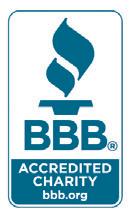


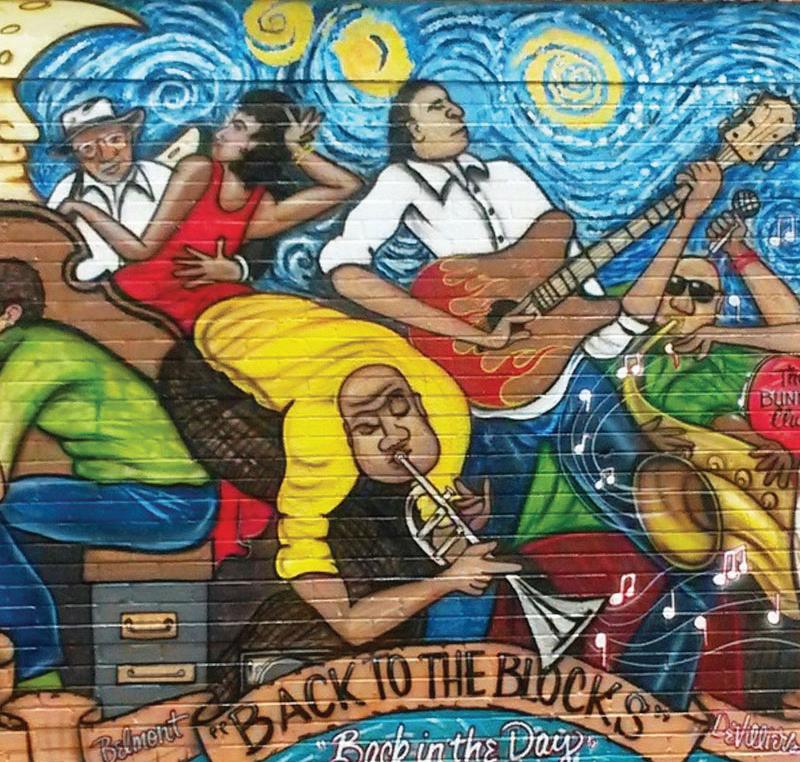







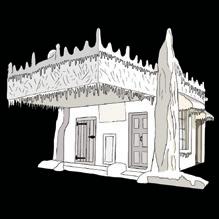

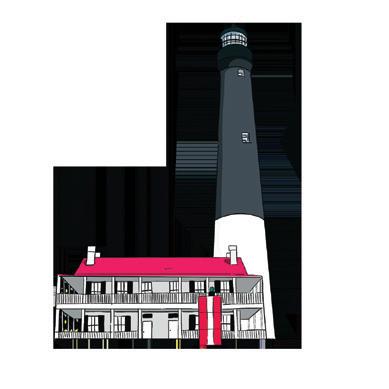


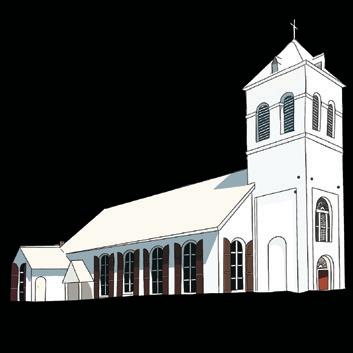









e ® to support manatees and their aquatic habitat. for a savethemanatee.org
1-800-432-JOIN (5646)
 Photo ©David Schrichte
Photo ©David Schrichte
Every year during March, Council on Aging of West Florida takes part in a national initiative for Meals on Wheels called March for Meals wherein organizations entice public officials and local celebrities to deliver those meals to homebound seniors. The senior gets to visit with a high-profile person, the public official is reminded of the need for their philanthropy and support, and the program as a whole receives a nice boost in publicity. This year, we were lucky to have Florida state Rep. Michelle Salzman deliver a week’s worth of nutrition to one of our participants.
While I was coordinating the logistics of the delivery with her, Rep. Salzman surprised me by asking what the recipient might like in a care package. I was caught off guard because in my many years of doing this, no previous March for Meals participant had ever asked such a thing. Now, don’t get me wrong: all of the past contributors generously donated both time and gregarious conversation. But to proactively offer something above and beyond the service you are being asked to perform on behalf of a nonprofit agency—this was new.
Rep. Salzman and I disagree about a whole host of issues. She knows this. We’ve talked about it. I similarly agree with our entire legislative delegation about most issues, honestly. But over the years, in talking to them, trading friendly barbs with them, and ultimately doing a lot of good alongside them, I’ve learned that the humans beneath the vote—the multifaceted people those clickbait headlines intentionally obscure— are very often decent, thoughtful servant leaders who are genuinely trying to make our area better for all and uplift the most vulnerable.
And look, I’m not saying that some of their positions are not legitimately harmful or have worrisome repercussions. But to assume they arrived at those positions via no internal conflict, via no honest feedback from constituents, and via no late-night weighing of those intricacies is to I think flatten the complex minds that are thinking critically about complicated topics.
Politics can be tiring and cynical and a race to the bottom. Politicians, similarly, can be selfish and narcissistic and narrow-minded. But, honestly, so can I. I make strawman arguments and pivot when I’m losing and engage in ad hominem all day long. That’s why engaging with the individual, rather than any given topic’s broadest strokes, is counterintuitively the only way you’ll ever shift someone’s perspective.
Musician Nick Cave said it well: “If we truly comprehend and acknowledge that we are all imperfect creatures, we find that we become more tolerant and accepting of others’ shortcomings and the world appears less dissonant, less isolating, less threatening… If we look with curiosity at people who do not share our values, they become interesting rather than threatening… Cultivating a questioning mind, of which conversation is the chief instrument, enriches our relationship with the world. Having a conversation with someone I may disagree with is, I have come to find, a great, life-embracing experience.”
After all, that is what we at Council on Aging do every day with our thousands of clients. We don’t judge their past and we aren’t angered or disheartened by their present. We don’t care if the policies they voted for in the past are now counterproductive
to their care. And we don’t let their addictions or unhealthy coping mechanisms devalue who they are as people. We engage with the person, dare I say with their soul, because that soul is a composite of good and bad, of inconsistencies and hard days and ultimately a need for help.
When we only interact with avatars online, when we are only fed people’s worst decisions and inclinations via our phones, when our biases precondition us to automatically hate one another based on a political party or a zip code or a vote or a quote from yesterday or ten years ago, we are not engaging with and serving the person underneath it all. We have no goals, only targets. We are tribalizing, circling the wagons and giving into every other evolutionary prejudice that encourages us to “other” others. If politics is the process by which values become real, it is the bad actors that adorn every substantive debate with an increasingly and obsessively partisan bent. That is not politics, and it’s certainly not how you build a coalition. When has yelling ever worked?
I’ll leave you with the words of Pauli Murray, a mixed-race, Yale-educated civil rights activist. As we seek to serve more and more people, as we remove the restrictions and stigmas around what aging means, and as we work daily and receive funding from those with whom we may not see eye to eye, these words encourage me: “I intend to destroy segregation by positive and embracing methods. When my brothers try to draw a circle to exclude me, I shall draw a larger circle to include them. Where they speak out for the privileges of a puny group, I shall shout for the rights of all mankind.”










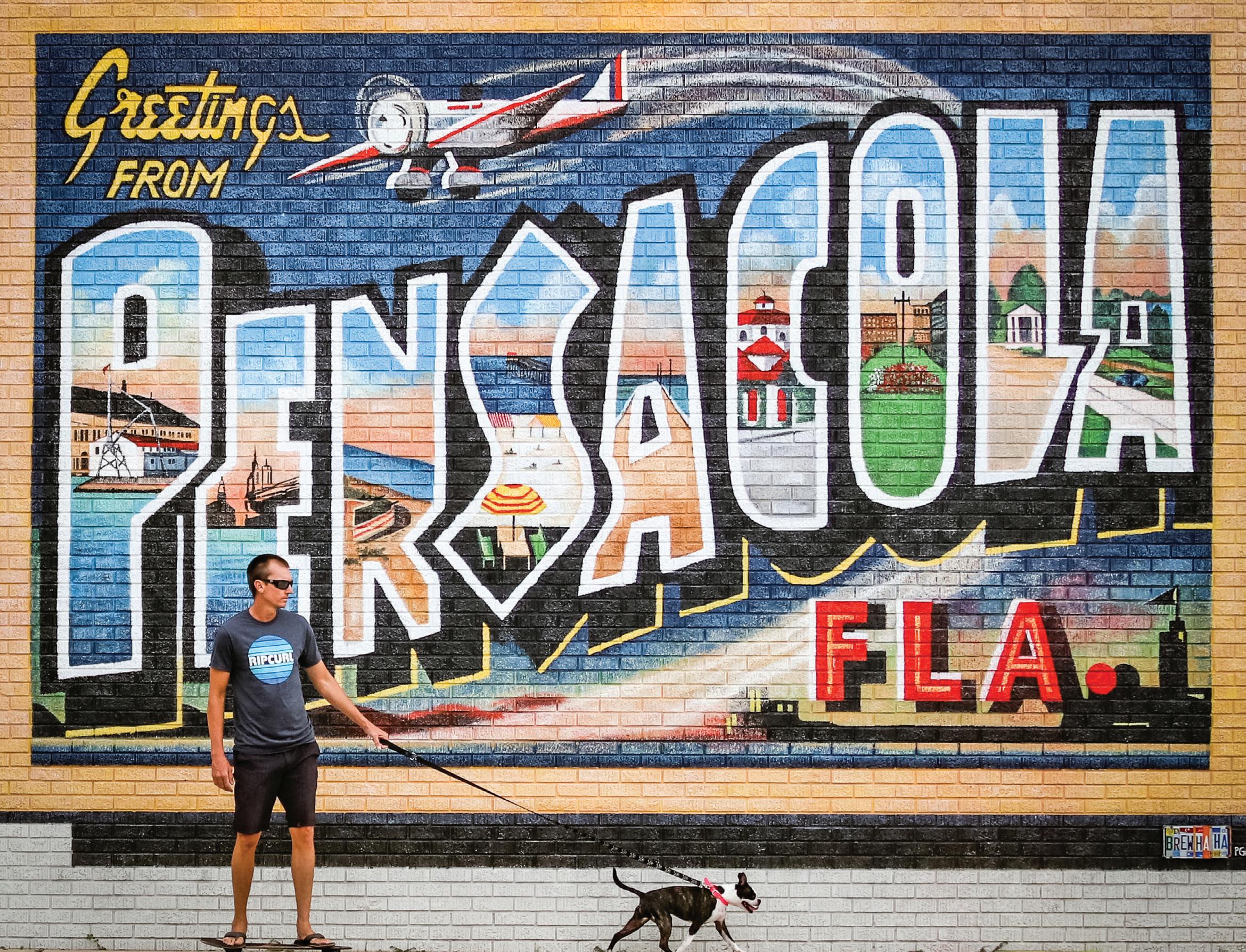
While public art certainly beautifies the communities in which they are installed, these accessible art projects also help to explore history, celebrate culture and inspire a sense of creativity and community. Beyond that, they are a lot of fun. Pensacola is home to dozens of unique public murals scattered throughout the city. We’ve rounded up a handful of beautiful, interesting and selfie-worthy murals that are perfect for a spring day adventure.
Say Cheese!
Location: Alga Beer Company, 2435 N. 12th Ave.
Artist: Patti Gillespie
This Pensacola postcard mural has become an iconic, must see (and selfie) landmark in Pensacola. Painted on the wall of Alga Brewing Company in East Hill, the mural is formatted like a vintage postcard with Pensacola landmarks and icons peeking through the lettering.

Location: Romana Street, between Palafox and Jefferson streets
Artists: Veronique Zayas and Somi Choi
Location: Jefferson Street, between Garden and Romana streets
Artists: Evan Levin and Ashton Howard
Funded by a Foo Foo Fest grant in 2016, the 3,000 square-foot mural stretches across the entire eastside wall of the Jefferson Street Parking Garage. Painted entirely by hand, the mural tells the story of Pensacola through its depiction of local landmarks such as the Pensacola Lighthouse and Fort Pickens, along with well-known icons like the Blue Angels and significant figures from our area’s Spanish roots like Tristan DeLuna.
In March of 2019, local artists Veronique Zayas and Somi Choi announced their “Call for a Wall” campaign. The goal was to find a Downtown Pensacola wall that could serve as the canvas for a piece that would become a downtown destination for Pensacola tourists and locals alike. Zarzaur Law, P.A. offered up their Romana Street wall for this locally focused mural that has since become a must visit selfie spot. The mural’s bright colors represent positive energy and Pensacola’s beautiful sunshine and water. The words, “Wish You Were Here” create an Insta-worthy backdrop and provide great public relations for Pensacola.


Pictured Mural: Port of Pensacola, c. 1903
Location: Voices of Pensacola Building, 117 E. Government St.
POP: Murals is a community initiative of the University of West Florida’s Historic Trust to display historically significant photographic murals throughout downtown Pensacola for residents and tourists of all ages to learn about the illustrious history of our great city. One of eight displays, the pictured mural offers a snapshot of Pensacola’s twentieth-century port and provides viewers with a panoramic insight into the bustling enterprise of industry of the Gulf of Mexico’s only deep-water port. To learn about the POP: Murals exhibit locations, visit historicpensacola.org/popmurals.
Location: First City Art Center, 1060 N. Guillemard St.
Artist: Daniela de Castro Sucre
In 2021, First City Art Center commissioned local artist and muralist, Daniela de Castro Sucre to create a mural for the working art center’s exterior walls. The concept behind the First City mural was the creative mind. Castro wanted the mural to represent the process of coming up with creative solutions. The mural depicts many hands stretching and pulling and playing. The main face is a child behind the hands holding something illuminated in his hands and looking at it in awe.

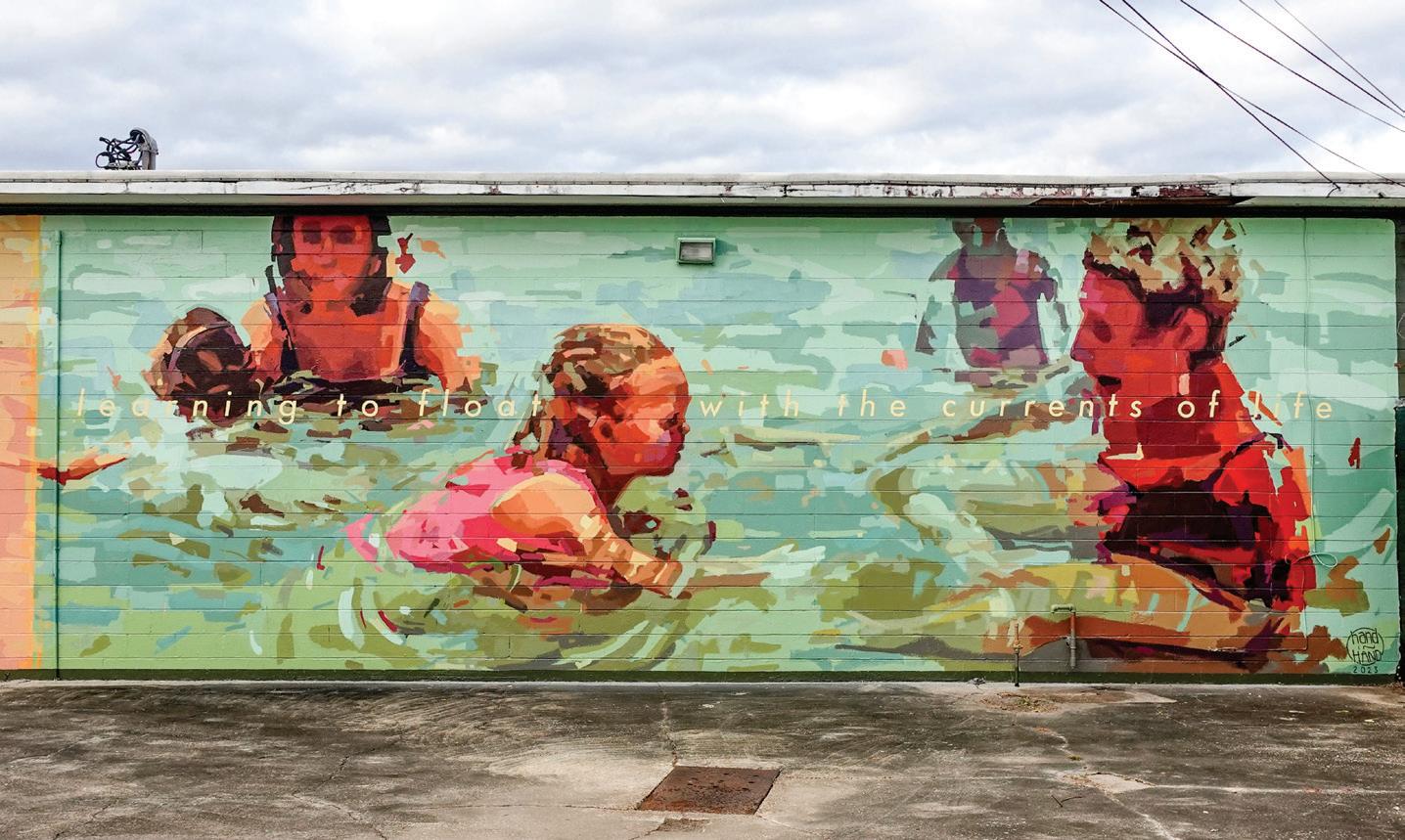
Location: 314 N. DeVilliers St.
Artist: Carter Gaston
The Belmont-DeVilliers neighborhood, known locally as The Blocks, is steeped in Black history. Once the commercial and cultural hub of Pensacola’s Black community, the Blocks was home to many Blackowned businesses, restaurants and music venues. One notable establishment was Abe’s 506 Club where musical legends like Louis Armstrong, James Brown, Ray Charles, B.B. King and Aretha Franklin all performed. Back to the Blocks is one of many murals near the corner of Belmont and DeVilliers streets that depict the economic and cultural history of the neighborhood.
Location: Posner Marine, 1710 Barrancas Ave.
Artist: Sarah and Andrew Wilson of Hand in Hand Creative
Painted for the 2023 Pensacola Mural Fest in conjunction with Foo Foo Fest, Float was one of five murals chosen to beautify buildings along the Barrancas Corridor in downtown Pensacola. Float is inspired by a personal photograph taken at Pensacola Beach. The artists wanted to illustrate the connection we have to one another, to place and to the water.

From ancient civilizations to contemporary times people across the world enjoy a comforting snack with a warm cup of tea. Tea time is an age old tradition that has continued to thrive. Today, when we think of tea, we envision fancy china, saucers, teacups, delicious pastries and piping hot tea. This tradition that we picture and know of today is called afternoon tea and became popularized in the 1840s by Anna Russell, the Duchess of Bedford.
In the nineteenth century, dinner was served later in the evening, typically around 8 pm. Due to the long gap between lunch and dinner, Anna enjoyed having a small meal consisting of scones, sandwiches and other treats alongside a cup of tea in between mealtimes. Many people followed suit and adopted this pattern of afternoon tea.
Today in America, tea is primarily served as a treat or special occasion. Afternoon tea is still the most common type of tea service today, consisting of light bites like finger sandwiches, desserts, pastries, and, of course, tea.
In addition to afternoon tea, cream tea and royal tea are also popular. Cream tea typically consists of scones, clotted cream, jam and tea. Some cream teas include Chantilly cream for an extra touch of sweetness. Royal tea is very similar and contains many of the same components of afternoon tea, but also includes a bubbly cocktail or mocktail.
From traditional afternoon tea service to fun and funky themed teas, there are several tea rooms and restaurants that offer tea services along the Gulf Coast. Attending a tea party is a fun activity that can be enjoyed by all ages. Consider treating yourself, your friends or your grandkids like princesses and princes by attending a tea service at one of the many tea houses along the Gulf Coast.
221 E. Zaragoza St., Pensacola
From traditional afternoon tea to themed tea parties, The Olde English Creamery hosts a variety of tea service options for every occasion. The Creamery offers Afternoon Tea, Children’s Tea, Light Lunch Tea, Cream Tea and many themed tea parties.
If you’re looking to sip tea like a Royal, look no further than the Creamery’s full afternoon tea experience. The Full Afternoon Tea includes a pot of tea, a variety of finger sandwiches (jubilee chicken, egg salad, cucumber and chive cream cheese), a sausage roll, a scone with clotted cream and jam and a selection of three sweet treats (a kiwi and strawberry pavlova, mini Victoria sponge cake and chocolate mousse). The Creamery offers a gluten-free version of the full afternoon tea so everyone can enjoy this wonderful treat. Reservations are required for those looking to experience full afternoon tea service.
If you’ve got a prince or princess of your own and want to treat them, the Creamery offers a Children’s Tea for those 3-11 years old. This tea service allows kids to have a real life tea party and enjoy a slighter smaller version of
the full afternoon tea. The Creamery also offers a Light Lunch Tea, which is a lighter version of the full afternoon tea. Served with your choice of tea, the Light Lunch Tea also includes five finger sandwiches, a mini sausage roll, scone, clotted cream and jam. For those wanting just a small taste of the traditional tea service, the Cream Tea is a great option. Consisting of a pot of tea, scone, clotted cream and jam, the Cream Tea is available for parties of one or two.
These teas are all permanent options on the Creamery’s menu. In addition to these teas, the Creamery also hosts both public and private themed tea parties for special occasions. Some of the themes that the Creamery has previously executed for parties include Harry Potter, Princess Tea, Bridgerton Tea and Downton Abbey. The Creamery also often hosts special themed tea parties in celebration of holidays, such as “Witches Brew” at Halloween and special teas for Valentine’s Day, Mother’s Day and Easter. Be sure to follow the Creamery’s Facebook page at @theoldeenglishcreamery to stay in the know of holiday events and special tea services. For more more information, visit theoldeenglishcreamery.com.

811 W. Garden St., Pensacola
For a Southern-inspired take on traditional British tea service, look no further than Adonna’s Cafe & Bakery. Adonna’s serves as a cafe and breakfast spot that also offers a few tea service options. Everyday Adonna’s offers Springtime Southern Tea, which includes finger sandwiches, fruit, a pastry, macaron and tea. The included sandwiches are chicken salad, pimento cheese and cucumber cream cheese. This tea service is available everyday during open hours, which are 9 am to 6 pm Tuesday through Friday and 9 am to 3 pm on Saturdays.
On Tuesdays from 2 to 6 pm, Adonna’s offers Mommy and Me Tea, for those looking to spend some quality time and enjoy delicious food with their loved ones. Even if your kid is grown up, you can still enjoy this special tea service because there is no age limit. Mommy and Me Tea includes your choice of four finger sandwiches—chicken salad, pimento cheese, cucumber cream cheese, peanut butter and jelly, cheese and butter, ham and cheese, and turkey and cheese—two cookies, fruit and a pot of tea or lemonade. Reservations for Mommy and Me Tea are accepted, but not required.
In addition to the listed tea service options, Adonna’s also hosts tea parties for special occasions or groups. For more information or to schedule a tea party, visit gardenstcafe.com.

106 N. Chicago St., Foley, AL
If you find yourself venturing beyond Pensacola, consider making a reservation at Copper Kettle Tea Bar for an experience you won’t want to miss. Whether you’re looking for a light bite and cup of tea or an all-out themed tea party, Copper Kettle is a great place to experience the many wonders of tea service.
Want to dine like a royal? Consider selecting Copper Kettle’s Royal Tea service. This filling option features all the delicious goodies present in afternoon tea, and more! Royal Tea at Copper Kettle includes two rounds of tea or coffee, a seasonal mocktail, a soup course with pastry cups, a selection of finger sandwiches, scones with fresh fruit and homemade whipped cream, a fruit and cheese platter, and a choice of two desserts— shortbread cookies, puff pastries, cake or chocolate fondue. With a selection this grand, you and your loved ones are sure to leave feeling like royalty!
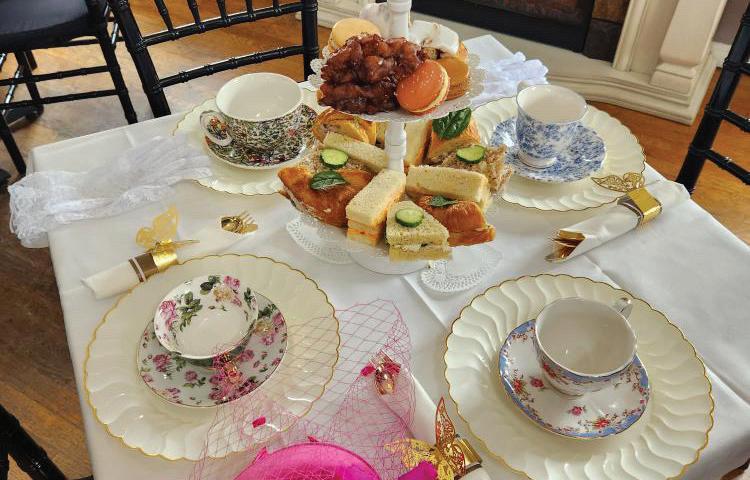
If you aren’t quite ready to immerse yourself in the grandeur of the Royal Tea experience, Copper Kettle’s Afternoon Tea is a smaller, but equally enjoyable tea service. Afternoon Tea gives guests the option of either two finger sandwiches or one sandwich and a soup. In addition, guests will receive scones with jam and Chantilly cream and two small desserts.
For those just looking for a sweet treat, Crème Tea or Dessert Tea make great options. Copper Kettle’s Crème Tea includes scones, jams, butter, Chantilly cream and tea. Dessert Tea includes three assorted desserts, homemade whipped cream and tea. Both CrèmeTea and Dessert Tea make great options for anyone looking to satisfy a sweet tooth.
As kids, many of us hosted fake tea parties with our dolls and plush toys. Copper Kettle has made this fantasy a reality with their “Teddy Tea” service. This tea service is designed to provide kiddos with a magical child-friendly experience that they will never forget. Instead of strong tea and adult-centric bites, Teddy Tea includes peanut butter and jelly sandwiches cut in fun shapes, crackers, scones, cookies, fruit, marshmallows and more. Kids will have the choice of their beverage including hot chocolate, teas and lemonades.
When booking one of these wonderful tea service options at Copper Kettle, consider adding a theme to your reservation to transform the decorations, server’s attire and menu items to fit the theme of your choosing. Popular themes include Alice in Wonderland, Harry Potter and Mermaid/Pirate tea. Regardless of the theme, all tea reservations will include decorations, table settings and beautiful flower arrangements.
Reservations are required for tea service at Copper Kettle. For more information and booking details, visit thecopperkettleteabar.com.
 by Carey Clarkson
by Carey Clarkson
Born from fathers looking to entertain their bored children in the mid-1960s, Pickleball has become the country’s fastestgrowing sport. Its growing popularity is attributed to its short learning curve and its accessibility to a wide range of ages and fitness levels.
Pickleball is a low-impact paddle sport that combines elements of tennis, badminton, and ping-pong and can be played both indoors and outdoors. The game is played with two to four players on a badmintonsize court with a pickle ball: a hollow plastic ball approximately .88 oz and dotted with evenly spaced holes.
As a low impact sport, pickleball is an excellent resource for our older community. “As we age we become prone to the effects of “osteoarthritis, heart disease, hypertension and diabetes,” said Andrew Lee, a local physical therapist for Start Performance Physical Therapy. Lowimpact exercise [such as Pickleball] can be an excellent way to maintain physical fitness. As a low-impact exercise, it reduces the compressive forces to our joints as well as the tensile stress applied to our muscles,
tendons and ligaments. “Lowimpact exercise has been shown to increase strength, flexibility and our balance which becomes increasingly important for the aging adult to staveoff the effects of frailty,” Lee said.
Lee explained that the sport serves as a good complement to those suffering with limited motion. “Aside from enhancing cardiorespiratory endurance, refining agility in maneuvering to strike the ball, and even fortifying strength through the repetitive motions of swinging the paddle, pickleball proves itself as a versatile and effective tool in advancing rehabilitation goals as well,” he said.
“Speaking specifically to older adults, the mechanisms which contribute to our sense of balance tend to decline as we age. Our proprioception (perception of awareness of the position and movement of the body), visual and vestibular systems (the system that functions to detect the position and movement of our head in space) face increased challenges to maintain our sense of balance and this is why our older adults are at a much higher risk of injury.
Socialization with other players in the Pickleball community creates a sense of belonging which is vitally important for our mental health.”

Pickleball is an excellent way to combat this decline as the sport requires quick reflexes and hand-eye coordination,” Lee explained.
Pickleball is more than a physical sport, it is a chance for the community to come together. As we age, our options for socialization may become limited, leaving some to feel isolated and alone.
“Pickleball has truly made a significant impact on the older adult population who are most at risk for social isolation amongst our society. Socialization with other players in the Pickleball community creates a sense of belonging which is vitally important for our mental health. Pickleball is an excellent exercise which provides multiple health benefits beyond the confines of physical health,” Lee said.
Pensacola has embraced pickleball with courts popping up across the city. At pickleheads.com, you can learn about the game and how to play it, research top rated pickleball
gear and shoes, organize games and find players. The site also lists many of the pickleball courts available in Pensacola, such as: Hollis T. Williams Park, with three courts; Gulf Breeze Shoreline Park, Bear Levin Studer Family YMCA and Vickery Community Center among others.
The sport has become so popular that Pensacola has launched the first phase of construction for an indoor pickleball court at the Port of Pensacola. The concept will also feature eight tournament-size outdoor pickleball courts. Players will be able to purchase annual memberships or for those not interested in a membership, courts will be available to rent by the hour.
To find more information on pickleball, where to find your local court or meet up with other pickleball enthusiasts, check out Pensacola Panhandle Pickleball on Facebook. You can also visit Pensacola Parks and Recreation at cityofpensacola.com.





We are worldbuilders. We develop great minds and inspired leaders. We help children write their own story. Gulf Coast Freedom Schools nurtures the world within through a free, six-week summer literacy and cultural enrichment program for students K-8th grade who reside in Escambia County.




Botanical gardens document and foster understanding and research for a variety of plants. These beautiful gardens host a vast array of plants ranging from luscious local flora to exciting exotic species. Many botanical gardens offer guided tours and activities such as workshops, horticulture lessons and more. The official role of a botanical garden is to serve as a living collection and record of various species of plants. These unique collections of botanical specimens serve as the perfect place to relax and enjoy some natural beauty. Fortunately, the Gulf Coast is home to a number of stunning botanical gardens for you to enjoy—all within a short drive of Pensacola.
B. Maclay Gardens StateAddress: 3540 Thomasville Rd., Tallahassee, FL
floridastateparks.org/MaclayGardens
First planted in 1923, this garden is host to all sorts of incredible sights and botanical related activities. The garden features two short nature trails for hiking, six miles of shared trails for hiking and biking, and five miles of biking trails overlooking the lake. Peak blooming season for the gardens is January 1 through April 30, with the floral peak in late February; a special fee is charged for visiting during these months.
 Alfred
Park
Bellingrath Gardens & Home
Alfred
Park
Bellingrath Gardens & Home
Address: 12401 Bellingrath Gardens Rd., Theodore, AL bellingrath.org
This impressive botanical garden first opened its doors in 1932. The vibrant 65-acre estate offers colorful sights all year round. While exploring Bellingrath Gardens, one can find beauty around every corner. The Bellingrath Rose Garden, The Delchamps Gallery of Boehm Porcelain, the Mirror Lake and the Asian-American Garden. The Rose Garden contains more than 2,000 plants with blooms typically occurring in late April. The Asian-American garden also features unique plants from China and Japan.
Address: 5151 Museum Dr., Mobile, AL mobilebotanicalgardens.org
Started in 1974, Mobile’s Botanical Gardens span a staggering 100 acres. This garden is the largest on the Gulf Coast and features the largest biodiversity of any botanical garden in the area. Currently in bloom are the Winter Garden, the Rhododendron and Azalea Garden and the Herb Garden. The Winter Garden features camelias, Asian magnolias, and Taiwan cherries. The Rhododendron and Azalea garden features evergreen azaleas in bloom, along with the native and Aromi azaleas blooming during the first half of April.

Address: 1010 Forest Ave., Montgomery, AL montgomerybotanicalgardens.com
Located within the heart of Montgomery, this garden features a beautiful assortment of flora that is sure to capture the eye of any visitors. The garden is located within Oak Park, and its goal is to enrich the park and celebrate Montgomery. Some of the wonderful features to visit include Monkey Island and the Gayle Planetarium. This site also offers an abundance of local history and the story behind the establishment of the Montgomery Botanical Gardens.
Address: 1066 Government St., Mobile, AL
cornerstonegarden.org
Cornerstone Gardens features not just one garden but a collection of gardens. The first garden is a lovely traditional British formal garden. After exploring the British garden the guest is then treated to a soothing fragrance garden which is perfect for the visually impaired. The next garden is the Japanese woodland garden, an eyecatching garden that features many native Japanese flora. Cornerstone also features many smaller settings around the main exhibits.

Address: 5 Victory Avenue, New Orleans, LA neworleanscitypark.org/visit-city-park botanical-garden
The New Orleans Botanical Garden, which was opened in 1936, includes a colorful 10 acres of enchantment within the city. Included within the garden is the Helis Foundation Enrique Alférez Sculpture Garden which features 15 statues by the New Orleans artist. On Saturdays and Sundays, one can visit the garden and enjoy the Historic New Orleans Train Garden, a stunning 1/12size train track with multiple small-scale trains. Among the plants featured in the garden, there is the Yakumo Nihon Teien Japanese Garden, a serene place to enjoy Japanese plants and explore Japanese culture with events such as tea ceremonies.
Address: 370 Ridge Rd, Picayune, MS
crosbyarboretum.msstate.edu
With a mission of protecting and showcasing the natural beauty of Mississippi, it is no surprise that the Crosby Arboretum features a remarkable arrangement of scenery and exhibits for guests to not only enjoy but explore. The arboretum houses around 700 acres of land with over 300 different species of plants. The land is split among seven different main areas which all house unique flora. The main three exhibits found within the arboretum are the Savanna, the Woodlands, and the Aquatic. All three of these exhibits feature a unique arrangement of both native and non-native plants, pleasing the eye of every onlooker.
Address: 2230 Spillway Rd., Brandon, MS
While not as large as some of the other gardens featured, one does not want to miss Reservoir Botanical Gardens. The garden is situated right next to a beautiful 0.6-mile nature trail that is surrounded by beautiful plants and shrubbery. Renovated in 1992, the Reservoir Botanical Gardens still holds up today as a bastion of serenity. If you are someone who enjoys a quiet stroll through nature, this is the garden for you.
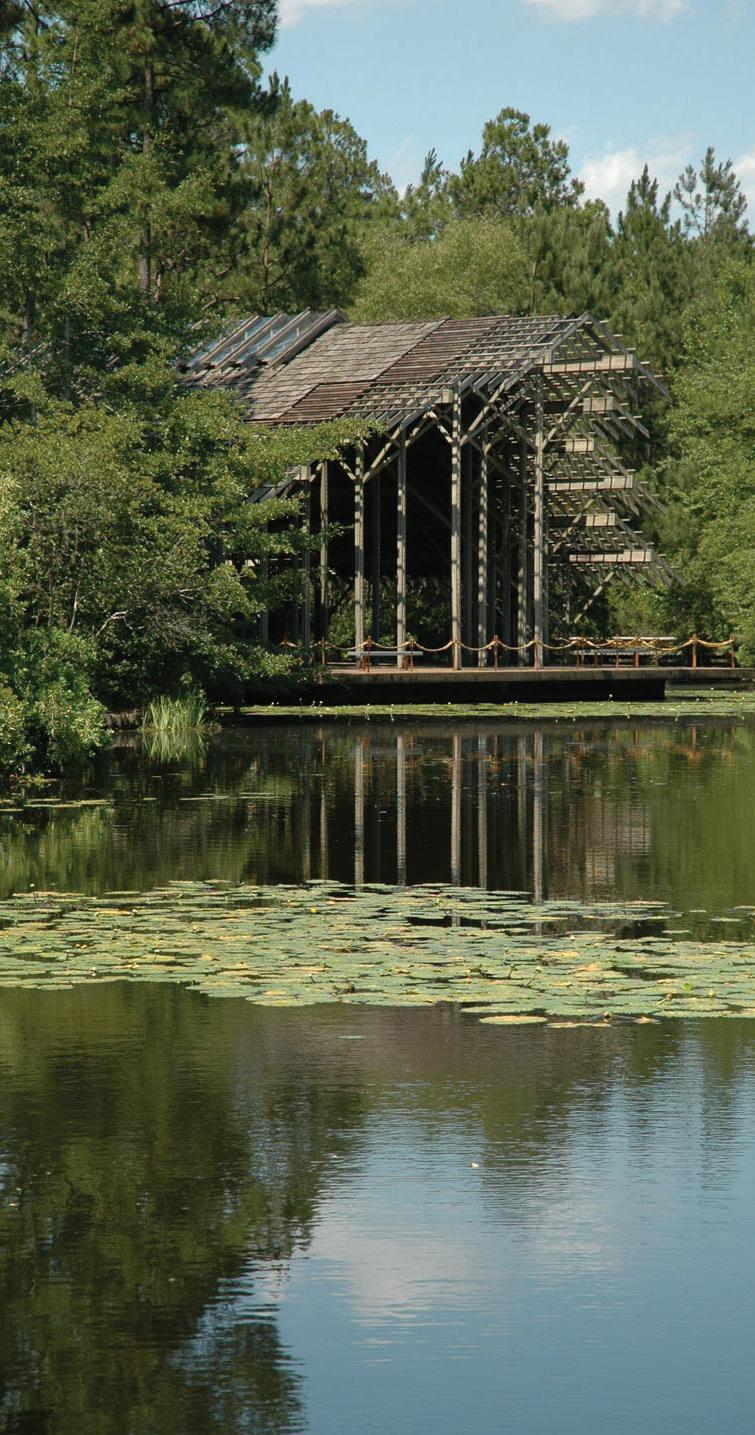
Reservoir Botanical Gardens
New Orleans Botanical Gardens

You may know James Reeves as a local attorney, a real estate developer, a former Florida State Representative, a former City of Pensacola Councilman, a founding member of the Irish Politician’s Club, a generous philanthropist or as the father of Pensacola’s current mayor. Even if you’ve never heard of Jim Reeves, your life in Pensacola has likely been touched by him in some way.
Born to Chester and Goldie Reeves in 1938, Reeves grew up in a two-bedroom home in East Hill. He and his brother John spent their summers running around East Hill and biking over to Bayview Park. His life as a businessman started early—at 11 years old, when he got his first job as a paperboy for the Pensacola News Journal.
After graduating from Pensacola High School, Reeves enlisted in the Marines and attended Pensacola Junior College (now Pensacola State College). He earned his undergraduate degree from Florida State University and his Law Degree from Stetson University College of Law.
When Reeves won his seat in the Florida House, he famously chartered a bus to carry his supporters to Tallahassee for the swearing in ceremony and his first session. While in the House, Reeves worked diligently for his district, enabling the creation of the Historic Pensacola Preservation Board, The Pensacola Escambia Development Board and the Downtown Improvement Board. Reeves left the Florida House when his seat was redistricted. He later went on to serve six years on the Pensacola City Council.
Reeves has been a principal developer in several high-profile real estate ventures, including the Aragon and Pensacola Beach RV Resort. He is well known for his community involvement and philanthropic endeavors. Reeves is active on many community and business boards including the Institute for Human and Machine Cognition, Pensacola Cultural Center, Tourism Development Council, Gulf Breeze Rotary and the Downtown Improvement Board. He also served as a trustee for the Gonzalez United Methodist Church and the Community Maritime Park Associates.
Reeves was recently named a Pensacola State College Foundation Fellow for his significant contributions to the college and for establishing the Molly McGuire School of Culinary Arts and its Endowed Scholarship.
Through his business endeavors, his political will, his charitable giving and his personal charisma, there can be no doubt that Reeves has made an indelible and meaningful mark on Pensacola. Coming of Age had the pleasure of speaking to Reeves about his life, work and his love of Pensacola.

COA: Tell me about your childhood growing up in Pensacola.
JR: My parents worked at Naval Air Station Pensacola. My dad ended up becoming a Quarterman, which is just below the senior staff level. My mom was like Rosie the Riveter. She worked during the war when my dad was overseas. She was a housewife after he came home. They had my brother who is a Presbyterian preacher. My mother named us James and John for the biblical brothers. He took the biblical responsibility. I took to the sin side. We lived in East Hill. My mom and dad had a house on North 16th Avenue. John Pace lived across the street with his new wife. I grew up in a two-bedroom, one-bath home. I shared a room with my brother. I went to Pensacola High School and then, I went into the Marine Corps because, at that time, they were drafting kids right out of high school. I didn’t want to go into the Army. It just wasn’t flashy enough for me. My dad had gone into the Navy and my uncle had been in the Army. I joined
the Marines. They had a program that you had to sign up for eight years. You went six months on active duty and then you were a reserve for seven and a half years. I went through that program, which means I missed the first semester of college. When I came back, I started the second semester, but it was my first at Pensacola Junior College (now named Pensacola State College). After I attended Pensacola Junior College, I attended Florida State University where I got my bachelor’s degree. Then I attended Stetson law School, where I went summer, winter and whenever the doors were open, so I graduated in two and a half years with a LLB Degree. I did in five and a half years what would’ve normally taken seven years.
COA: What inspired you to go to law school?
JR: In my last year at Pensacola High School, I put up political signs for J.B. Hopkins. He was in the legislature, and he was a lawyer. He was kind of a mentor and idol. I wanted to be a lawyer, and I wanted to get into politics from the very first. I wanted to be like him. Plus, the Marine Corps made me want to become my own boss.
COA: You served in the Florida House of Representatives from 1966 to 1972. What was that experience like and what are you most proud of from your time in government?
JR: Well, in a way, my time in government is not over. But in the six legislative years, I created the Pensacola Escambia Development Council (PEDC), The Downtown Improvement Board (DIB) and the Historic Pensacola Preservation Board.
COA: Tell me about the Historic Pensacola Preservation Board. I’ve read that nobody seemed to care a lot about downtown historic buildings at that time. What made you have the vision to see that we needed to create this board to protect our historic places?
JR: I can’t take any credit for it. I hired a local advertising agency when I campaigned for the legislature, and their lead guy was a big history buff. He’s never gotten a lot of recognition. He said we need a historic preservation board, so I campaigned on that. When the legislature convened in 1966, Governor Kirk, the only Republican governor since Reconstruction, was in office. He said there was going to be a 5 percent across-the-board cut of state agencies.
Reubin Askew was a state senator at the time and ultimately became governor. We had four members in the House from Escambia and two in the Senate. Reubin Askew said to me, “He’s got a five percent cut across the board. There’s no way in hell that you’re going to get to establish this commission. And there’s no way in hell you’re going to get an appropriation of $200,000.” I was never so proud as when I walked down the hall to Reubin’s desk in the Senate. I said, “You know that bill that you said I wasn’t going to pass? I just
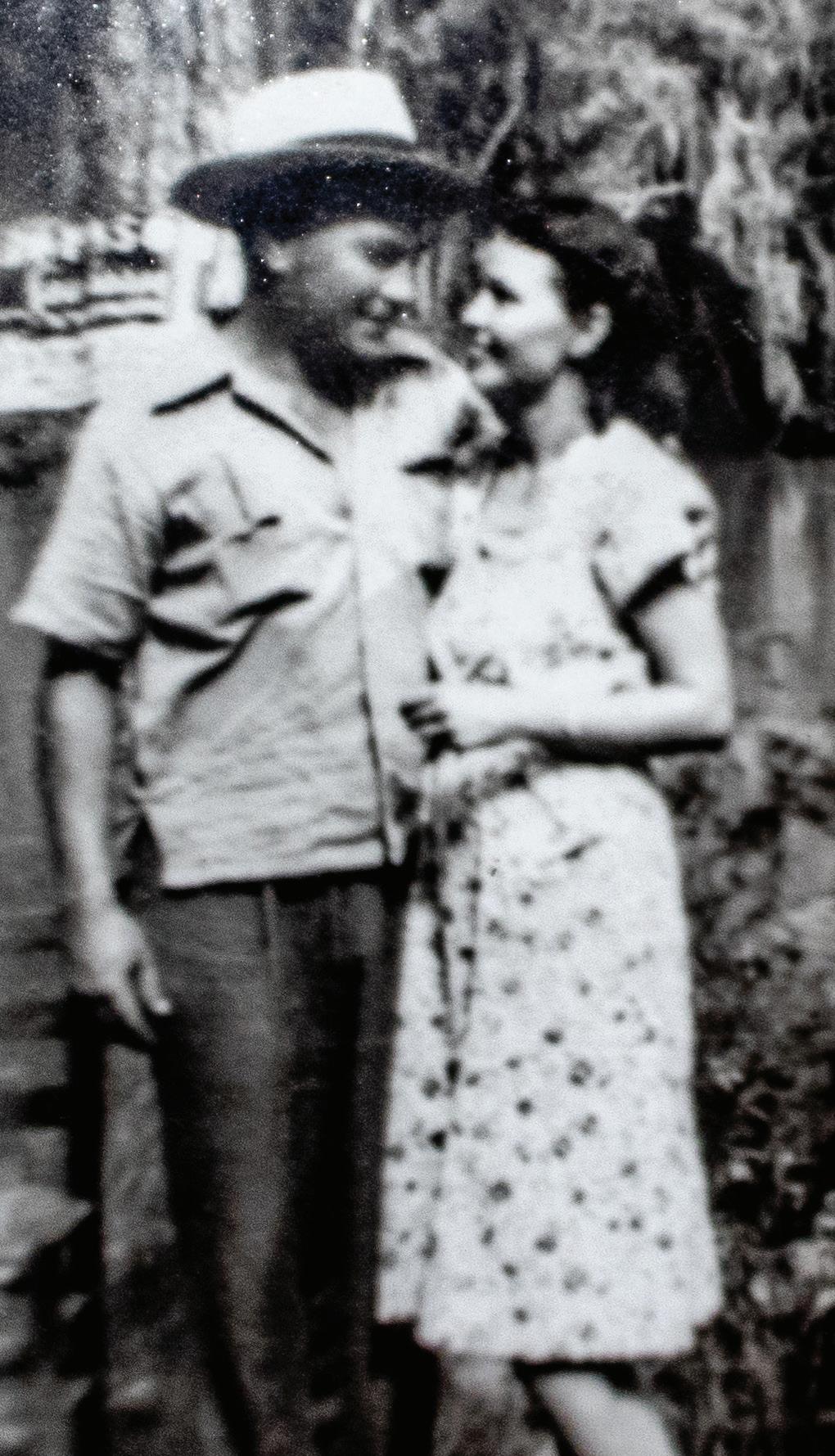 A young Jim Reeves
A young Jim Reeves
passed it 119 to 1.” (There was one guy from Hillsborough who just didn’t believe in it, so he voted against it). Reubin said congratulations and the next day, I was sitting at my desk in the House and Reubin came down there. He said, “You know that bill you passed yesterday? Well, I just passed it in the Senate. But it was 40 to 0.” I had somebody vote against me, so he had to one-up me, but that was okay with me. But then you had to worry about the governor’s veto. Well, remember the governor was a Republican. The chairman of my campaign was a big-time Republican. When I first started, I thought it would be good to have a Republican campaign agency with a Republican Governor and it paid off. He didn’t veto the bill. He signed it. He could have just let it become law or whatever, but he signed it. It’s funny because he had a broken arm at the time. Those are probably three items that continue from that time. Then I got reapportioned out. What I mean by that is that I was in District Four. District Four moved to Santa Rosa County, and I had a friend that was holding that seat, so just didn’t run for re-election. My term just ended. Quite honestly, I never got tired of kissing babies, but I got damn tired of kissing asses.
COA: Beyond your work in government, you’re an attorney and a real estate developer. Tell me a bit about your legal career.
JR: Let me just tell you the truth. Fred Levin had graduated just a year before me, and he’d come back to practice. So, I thought I would be a trial lawyer, too. Well, I had three cases. This is the honest truth. One was a condemnation, where I was representing a person whose land had been condemned for a road. So, we’re going to win, the question was how much were we going to win?
I won that case, and my client was happy with the amount of money. After that, I had an accident case, and it went to a jury. The jury said neither party was at fault. So, that was a tie. So, one win, one tie. I took
a DUI case and tried it with a jury, and I lost the case. But even the jury said to the judge, “You ought not to take this guy’s license away.” This is before Mothers Against Drunk Driving. He got probably the lightest sentence anybody convicted of DUI ever got. They thought he was guilty on the evidence, but he was a nice kid. So, I said, screw this. It’s too much preparation. I went into real estate closing, working with home builders, developers of subdivisions, and people who wanted to borrow money. I had absolutely no fantastic legal career. Nothing illustrious. But what I did discover is that lawyers are like owning a restaurant. If enough people come in, you can make a profit.
COA: You were born in 1938 and you’ve lived most of your life in
Pensacola. The city has changed so dramatically in your lifetime. What do you think about its growth and its evolution?
JR: Well, number one, I was here when people didn’t want us to grow anymore. Here’s what happened— JCPenney and Sears were on Palafox Street, and they moved out to the sprawl and suddenly, downtown was abandoned. You didn’t see anybody downtown. Nathan Kahn and a couple of guys from downtown came to me and said, we want to create the Downtown Improvement Board and we want to levy this tax. Even though that’s a local bill, not everybody wants a tax. People agreed with what we wanted to do; they just didn’t want the tax. So, there was a lot of opposition to it. But that was the purpose—to try to
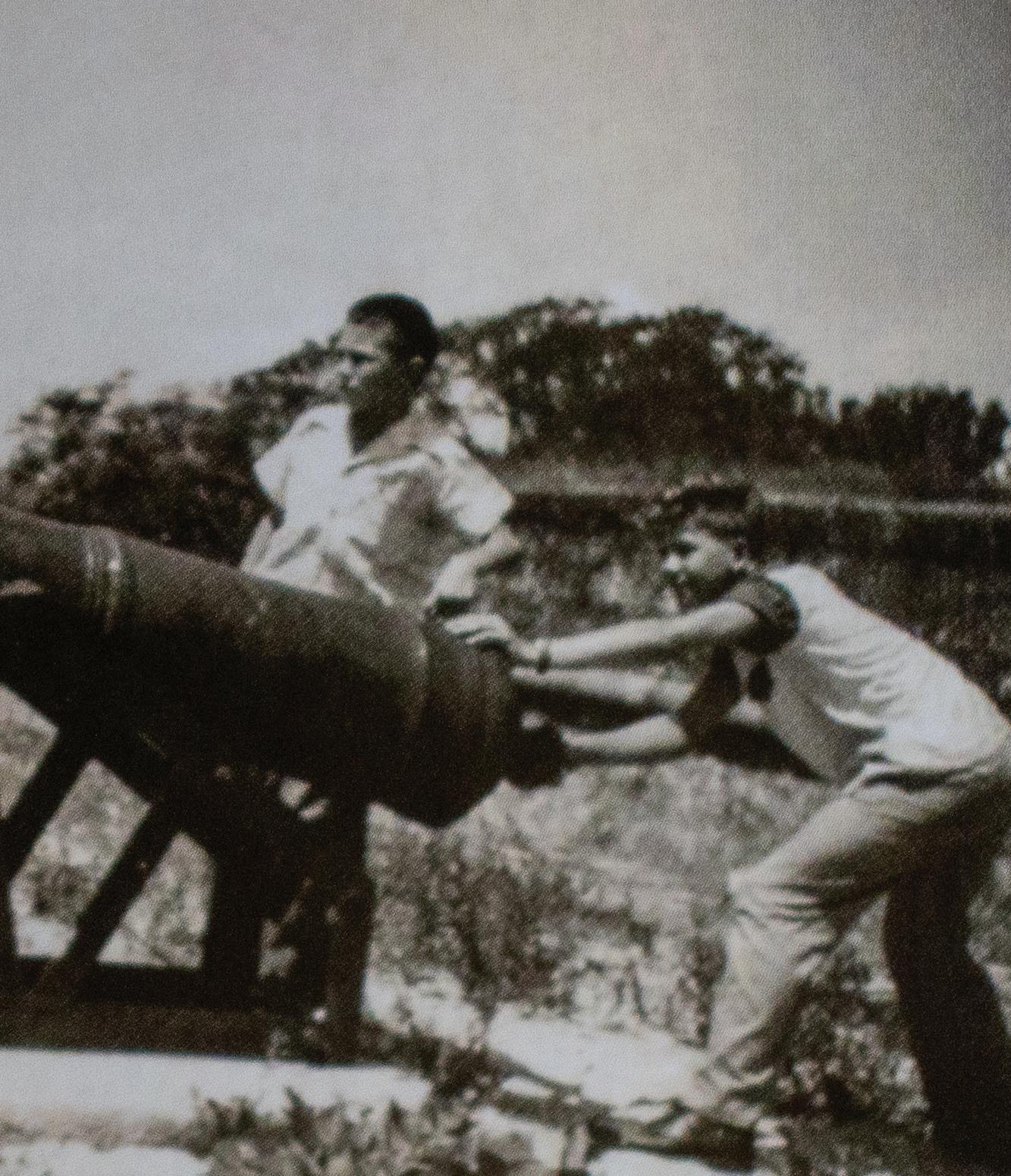
rebuild downtown. Now the spark that really rebuilt downtown was Quint Studer, in my opinion, and some people don’t want to give him credit. But it’s like McGuire says, “You put another restaurant next to mine, it improves my business.”
COA: Speaking of McGuire’s. Tell me about starting the Irish Politicians Club (IPC).
JR: Well, I didn’t do that either. I met McGuire when he had a place out on Fairfield Drive in a mall complex called Fairfield Plaza. He and Molly had just married and moved here from New Orleans. The owner sold the complex and McGuire wanted to move. I put together a limited partnership and I raised enough money to put a down payment on the old firehouse that became the McGuire’s restaurant.
When it was all said and done, McGuire was appreciative and he said, “What do you want?” By that time, I’d been in state politics, and I served six years on the city council. When you’re a politician, or an old politician, it takes you a long time to get from your car to
the table in a restaurant or from your table at a restaurant to the bathroom. Everyone wants to talk to you. So, I said, “I want one private table to call my own and I want to be able to come in the back door through the kitchen.”
He asked me what I wanted as a way of showing his appreciation, and that’s what I requested. Later, McGuire got an advertising guy, his name was Cooper Yates. Yates said, “McGuire, we need to create this Irish Politicians Club and we’re going to have trips to Ireland, and we are going to charge $40 a month.” Well, $40 a month was too much. We only had one room and it had four tables. McGuire said to me, “What do you think?” I liked Cooper, so I said, “Okay, let’s go with it.” We had 10 Charter Masters at that time and each one got to pick five more people. So, we had 60 people to start. I said to McGuire that I would only agree to this if the dues were only $12 a month and we don’t promise them squat except the private room. That’s how we started--with 60 members and four tables. But as he added on to his building, he added on to the club.

We don’t have any meetings. We have three socials a year—a Christmas party, a party right before football season starts, and then we have one after St. Patrick’s Day in April.
COA: Going back to the growth in Pensacola. As a real estate lawyer and developer, what are your thoughts on the affordable housing issue in Pensacola?
JR: As a developer, I talk in two languages—affordable and attainable. Affordable is a veteran who gets $1,000 a month and can pay $300 a month in rent or attainable housing is housing that you can get on a beginning schoolteacher’s salary, let’s say it’s $40,000. I take off 30 percent and that’s about $12,000 a year or $1,000 a month. So, I’ve got one group at $300 a month (affordable) and I’ve got another group that’s paying $1,000 a month (attainable). So, what the $300 a month people are paying for is the insurance and maintenance, as they are not paying any real estate taxes. In this case, you need 100 percent grants and loans from some agency—the city,
 The chartered bus that took Reeves’ supporters to his swearing-in ceremony
The chartered bus that took Reeves’ supporters to his swearing-in ceremony

the county, the federal government, the state government. In other words, the deal is heavily subsidized
COA: Let’s talk about your personal life a little bit. You have five children. Tell me tell me about them.
JR: My five children, thankfully, have never gotten into any kind of trouble for drugs or anything else. I say that to people, and they always say, “Oh, you mean they didn’t get caught?” No, they didn’t get into any trouble. I felt like I owed them all a college education. So, four of them all went to college and then J.J. went on to law school. My oldest son, James J. became a gourmet cook. Now he is a licensed boat captain, and he has a two-mast sailboat with lots of beautiful teak. It’s just beautiful, the whole thing. He’s rebuilt it from scratch. He’s talented, he’s just talented in a different way. My first daughter, Michelle, is from my first marriage. She’s an architect and developer. My second wife and I adopted our first son, James J., through the Children’s Home Society. Then, we adopted Rachel who’s now
married to a captain in the Navy, and she’s got three great kids. Then, I married Connie. We had J.J. who’s a lawyer in New Orleans, and then came D.C., who is the youngest and the present mayor of Pensacola.
COA: All your children are successful. I’m sure you’re proud of all of them. In recent years you’ve had a particularly unique relationship with D.C. since he has become the mayor and you are a developer in Pensacola.
JR: I’m proud of all of them. D.C. said to me after he was elected, but before he was sworn in as Pensacola’s 64th mayor, “Whatever you and Quint need from the city, get it in while Grover Robinson is still in office because you’re not going to get squat from me.” And thet’s the way it’s been, but luckily, I don’t need much. I do get to spend father/son time with D.C., and I love hearing how good of a job he is doing (from him).
COA: Tell me the story of the Rolls-Royce.
JR: I bought that from Wally Yost. The rumor was that it had belonged to one of The Beatles. But the truth of the matter is, the Rolls Royce broke down out there about where it is right now. It needed an ignition switch. This had to be in the early 90s and it cost $981 to fix it. It was
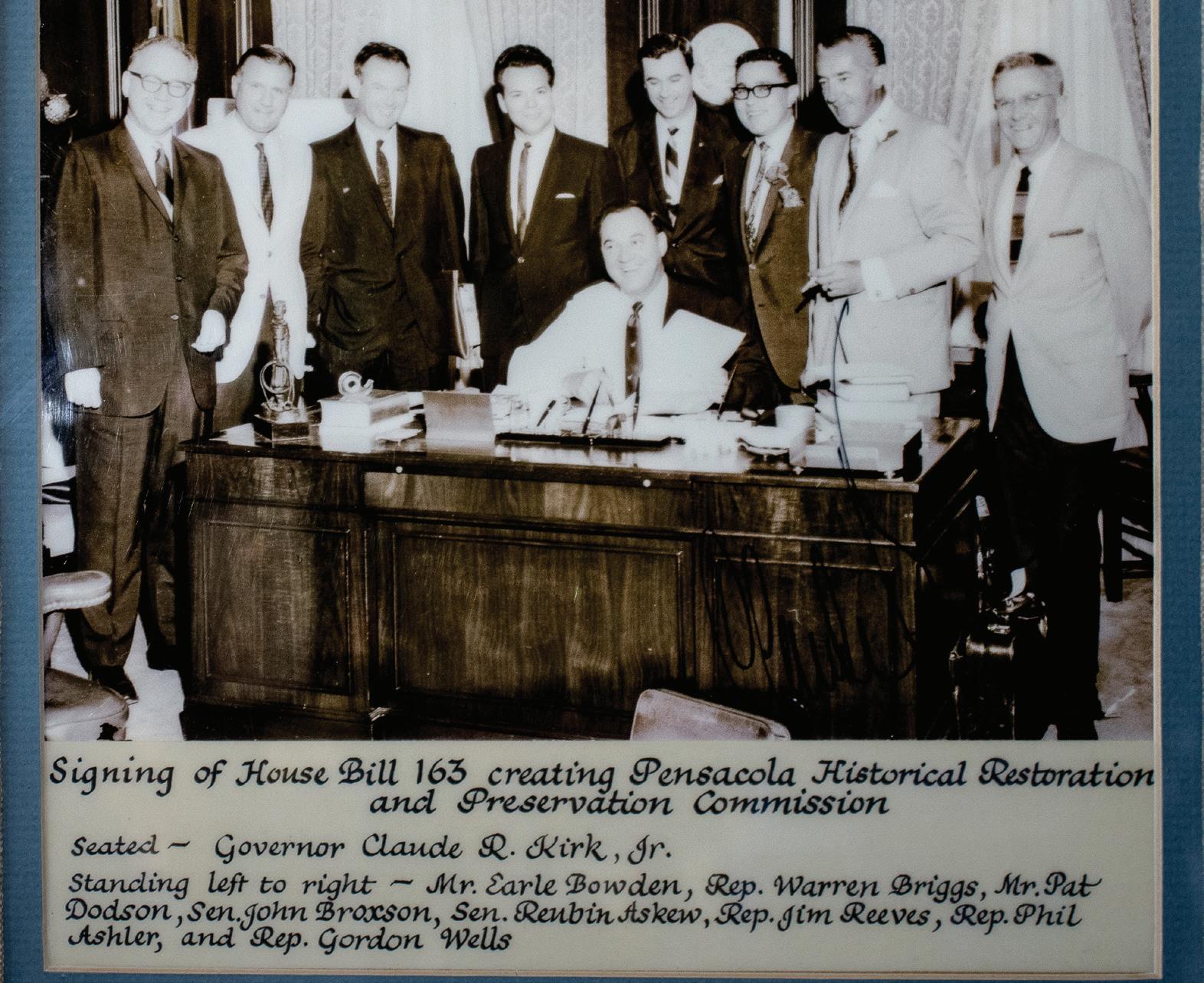

just hard to maintain. That’s the story, its my sign. The rumor is John Lennon owned it, but I don’t know.
COA: What charities are closest to your heart?
JR: Pensacola Little Theatre. It’s not a charity, but it’s a nonprofit. Pensacola State College, too. I think that President Meadows has done a really good job and I always say he’s the best president Pensacola State’s ever had. Now, I mean it from the beginning when it was Pensacola Junior College, but he always says, “That’s easy for Mr. Reeves to say because I’m the only president Pensacola State College has ever had.”
COA: You were named a Pensacola State College Foundation Fellow for your personal donations and for the scholarship you established with the Irish Politicians Club (IPC). Tell me about that.
JR: I’ve donated more than $260,00 to PSC and we did get the culinary
school named after Molly McGuire and then the IPC funds the Molly McGuire Culinary Arts Scholarship. Our IPC dues are only $20 a month, but we added $100 for the scholarship. I just gave Pensacola State College $32,500 from the IPC for the scholarship. We have about 325 members, so at $100 a pop that ends up at $32,500 a year. We’ve got about $550,000 in that scholarship program right now. So, for all the bad we do in the Irish Politicians Club...
COA: What bad do you do?
JR: Just read about it. Anything you can think up, they’ll write about it, but we’ve never done anything bad.
COA: What other projects do you have in the works?
JR: Well, I try to work on the impossible. So, my two things right now are homelessness and childcare. You know ages one through five are the most important years, and we turn
those kids over to people who make $12 an hour. My concept is that we pay everybody $20 an hour and that every childcare center is connected to some educational institution. It could be high school or middle school or a college, but every childcare center is connected so that institutions and teachers can mentor, so to speak. Just an idea right now.
I’m also building a 30-unit set of cottages for rent on Bayou Chico. We haven’t gotten the permit to build yet, but in addition to buying the land, I built a 13-stall dock. I went ahead and did that because I finally got that permit. So, I’ve got the most beautiful dock on Bayou Chico, but nothing is built there yet.
I’m part of building seven tiny houses for people aging out of the foster care system.
I’m chairman of Prison Rehabilitative Industries and Diversified Enterprises, Inc. (PRIDE) in Florida, which means if prisoners do any work, they’re working for our not-for-profit. So, if they make tags or false teeth or eyeglasses, they’re working

for PRIDE. I worked for ever and ever to get PRIDE, Pensacola State College and the Department of
Jim Reeves holding the bronzed baby shoes of his youngest son, Pensacola Mayor D.C. Reeves.
Corrections to certify prisoners in the construction trade. To Senator Broxson’s credit, he got them all together because he was chairman of the Senate Appropriations Committee. Our mission is to build tiny homes at the Century Correctional Institution. The goal is that you can just load them up on a truck and then set them down on a foundation somewhere. In doing that, the prisoner gets a certification as a carpenter, a plumber, an electrician or an HVAC tech. When they get out, they can find a job, and the biggest reason for guys to come back to prison is that they keep on doing what they were doing, and then they just go back. So, it’s my recidivism plan. They’re going to get the certification; they’re going to get a job and they’re not going to come
back to prison and taxpayers save $32,000 a year for each inmate that does not return.
COA: Tell me about your hobbies. What do you do for fun outside of business and philanthropy?
JR: I love to travel, and my wife loves to travel. I hold season tickets to the Pensacola Opera, the Pensacola Little Theatre, the New Orleans Saints and the FSU Seminoles.
COA: Where’s your favorite place outside of Pensacola?
JR: Well, it used to be San Francisco but not anymore. So, it’s probably New Orleans. I like Nashville. I like Atlanta. But it’s probably New Orleans. I have a condo there, so I have a place to stay on St. Charles Avenue. It’s much more of a pleasure because of that.
COA: What is your secret to staying young in mind, body and spirit?
JR: There are only three things I always try and do. Walk five miles every day except Rotary Tuesdays, never lose interest in trying to find ways to help people who want to help themselves and thinking of ways to make my hometown of Pensacola better.
Jim Reeves and his wife, Susan, on vacation in Madeira, Portugal.
Gulf Winds Credit Union’s Kites on the Coast Soars at Pensacola Beach
Gulf Winds Credit Union Kites on the Coast took place at Casino Beach March 15-17 with an array of massive kites from Chicago Kite and speedy stunt kites from the Michigan-based team SkyFX. This high-flying festival is presented by Council on Aging of West Florida as an intergenerational community event, raising funds for senior services through sponsorships and donations at the event. While kites are the centerpiece of the festival, the event also included kids’ activities, food trucks, and music from Cat Country and local ukulele group, The Ukuladies!


Council on Aging’s Senior Volunteer Program’s annual fundraiser cook-off competition Granny Get-Down took place March 9, 2024, at the Bayview Senior Center, raising more than $6,000 for Senior Volunteer Programs at Council on Aging! Senior Volunteers went head-to-head in a cooking and baking competition, offering tasting portions for judges and the public to sample. Proceeds from the event benefit two volunteer programs: Senior Companions and Foster Grandparents. Senior Companions volunteer helping another older adult continue to live independently at home, and Foster Grandparents serve in schools mentoring children in the classroom.

Salzman
During the month of March, Council on Aging participates in March for Meals, a campaign commemorating the anniversary of the amendment to the Older Americans Act to include a national nutrition program for seniors. We spotlight the program by working with prominent locals to help deliver meals to senior program participants to raise awareness for the services and population served by this program. This year Rep. Michelle Salzman took part, making an early morning delivery to her constituent Margaret. The pair had the opportunity to discuss some of the challenges many seniors face in getting proper nutrition along with other supplies and home goods.
Many thanks to our donors. We appreciate your generous support. Gifts received from January 2024 – March 2024
Abigail Williams
American Online Giving Foundation
Angie Keys
Anna Hornsby
Ascend Cares Foundation
Barbara Hudgins
Barbara Rue
Brenda G. L. Berry
Brenda Joyce Parker
Brenda Spencer
Brenda Stanberry-Davenport
Bruce M. Taylor
Candy Luciano-Green
Carolyn Phillips
Catherine Myers
Cathy Rudd
Centennial Bank
Charlie Nichols
Cheryl and Cheryl Wasdin
Cindy Wine
Cleova Fox
Constance Gordon
CPC Office Technologies
Cythia L. Gantt
Daniel Lindemann
Dave and Mary Hoxeng
David Alexander Iii
Dawn Shumaker Smith
DBA Wildcat Soaps & Candles
Deanna Cardineau
Debra Alonso
Debra Clancy
Denise Ard
Denney Rarrick
Dennis and Sharon Rudowski
Donna Flynn
Donna M. Harris
Doretha Davison
Eleanor Blunt
Emma Dees
Eugene Robichaux
Eugenne Dickerson
First Christian Church- Disciples Women
Francis Gilley
Fred & Marilyn Levin
Family Foundation, Inc.
Frontier Motors
George and Fredrica Prettyman
Greek Orthodox Ladies Philoptochos of the Annunciation
Greek’s Catering and Events
Gulf Coast Camera
Gulf Winds Cares Foundation
Gwendolyn Jackson
Habitat for Humanity
Heather Cromer
Helen Adamson
Herman L. Franklin
J M ‘Mick’ Novota
Jacquelin Britt
Janet Reeves
Janice Hervieux
Jenny Allison
Joseph Stanberry
Judith Johnson
Karen Adams
Ken and Rhoda Somerville
Krewe of Priscus
Lalareen Dees
Lawrence A. Jones
Lejoya Fails
Linda Harris
Linda Luttrell
Linda Tillery
Lucy Hemming
Lydia Darnes
Malvanice Adams
Manita Samuel
Maranda Shelton
Marcie Walker
Maria Vigodsky, LLC
Marjorie Macks
Mark and Diana Melton
Marla Elkins
Marny Needle
Mary Carter
Mary Mathews
Maureen Kucala
Medical Center Clinic
Michelle Liechti
Mildred Peacock
Minnie Skanes
Modern Woodmen
Mr. Joe Patti’s Seafood
Nancy Bennett
Ochsner 65 Plus
Order of AHEPA Daphne Chapter No 296
Parmelie McManamy
Pat Newman
Pauline Nelson
Pensacola Beach Elks Lodge 497
Perrye Riley
Priscilla O’Rear
Rebecca Bailey
Rebecca Hurley
Robert Fabbro
Robin Ouellette
Robyn Linton
Ron Ringo
Rosa Sakalarios
Rose Auld
Sam & Priscilla Forester
Sheree and Earl Roberts
Sonshine Companion Care
St. Christopher’s Episcopal Church
Stanley and Mary Bruce
Stephanie Hogg
Susan Hannon
Terry and JoAnne D. Meyer
Theresa Messick
Tony Uriz
Travis High Sells Houses
Trinity Health
Waffle Boutique
William J. Trushel
Yvonne Campbell
Council on Aging of West Florida is a local independent 501(c)(3) not-for-profit organization that has served seniors and their families since 1972. Council on Aging of West Florida helps seniors in Escambia and Santa Rosa counties live healthy, safe and independent lives in their own familiar surroundings by providing community-based, inhome programs and services such as Meals on Wheels and Alzheimer’s respite care. For more information, call 850-432-1475 or visit www.coawfla.org.
A copy of the offical registration and financial information may be obtained from the division of consumer services by calling 1-800-435-7532 toll free within the state. Registration does not imply endorsement, approval or recommendation by the state. The registration number assigned to Council on Aging of West Florida, inc by the florida department of agricultural and cosumer services is ch201. Council on Aging of West Florida does not use a professional solicitor or professional fund raisng consultant for the purposes of soliciting funds. 100% of donations go to Council on Aging of West Florida, Inc.

Navigating heart care can be challenging. With the latest treatments and innovations and the area’s largest, most experienced heart team, let Baptist Heart & Vascular Institute make it better.